Application of pulsed chemical vapor deposition on the SiO2-coated TiO2 production within a rotary reactor at room temperature
Ke Yang, Shan Zhong,*, Hairong Yue,2, Siyang Tang, Kui Ma, Changjun Liu, Kai Qiao, Bin Liang,2
1 School of Chemical Engineering, Sichuan University, Chengdu 610065, China
2 Institute of New Energy and Low-carbon Technology, Chengdu 610207, China
Keywords:Film Pulsed-CVD Scale-up Deactivation Pigmentary properties
ABSTRACT Pulsed chemical vapor deposition(P-CVD)is a promising technology for the surface modification of TiO2 particles.For the scale-up application of P-CVD, a custom-designed rotary reactor and corresponding coating process at room temperature was developed in the present work.The obtained SiO2-coated TiO2 particles were characterized by various measures including high-resolution transmission electron microscope, Fourier transform infrared spectroscopy, X-ray diffraction, etc.The results illustrated that the SiO2 films with a thickness of(3.7±0.7)nm were successfully deposited onto the surface of TiO2 particles.According to the dye degradation tests and acid solubility measurement, the deposited film can effectively inhibit the photocatalytic activity and enhance the weatherability of the TiO2 particles.Zeta potential measurements showed that the SiO2-coated TiO2 is possible to be stably dispersed in the pH range of 6.9-11.6.The coating process made the whiteness of TiO2 particles decreased slightly but still sufficient (97.3 ± 0.1) for application.Furthermore, the properties of the TiO2 particles coated by PCVD were compared with the particles coated by traditional wet chemical deposition.It is shown that the P-CVD can produce thinner but denser films with better photoactivity suppression performance.The developed coating process within the rotary reactor was proved practically feasible and convenient for the scale-up production of SiO2-coated TiO2 via P-CVD.
1.Introduction
With outstanding optical performance, titanium dioxide (TiO2)is recognized as the whitest pigment in the world, being extensively applied in various industrial areas, including painting, plastic,cosmetic,paper production,etc.[1-3].During the application of TiO2as pigment,normally the particles require extra surface coating for the improvement of photostability.Otherwise, the photocatalytic activity of TiO2will promote the degradation of surrounding substrates, causing the paints to undergo discoloration,roughening and pulverization,especially under ultraviolet exposure [4].A popular surface modification technique is to coat the TiO2particles with inorganic inert layers such as SiO2[5,6],Al2O3[2,6], ZrO2[7],etc., so as to isolate the surface of TiO2from air and also to shield the active sites of TiO2.Binary inorganic films deposition is more common during the practical productions,which can further improve the pigmentary performance and the weatherability of TiO2particles [7-9].Apart from the inorganic films, sometimes the organic layers are also required to improve the water dispersion stability or other pigmentary properties[7,8].
Nowadays, wet chemical deposition is the mostly employed technique in the commercial TiO2productions for the inorganic coating of TiO2particles due to its simplicity, cost-effectiveness and versatility[10,11].However,the wet chemical coating process requires further operations such as filtration and drying before packing, and also waste water treatment, leading to a prolonged process and higher energy consumption [12].The deposited film via wet chemical method is normally porous, and it is difficult to control the thickness and uniformity of the film layer at the subnanometer range [2,13].
In order to overcome the referred disadvantages, gas phase deposition techniques including chemical vapor deposition (CVD)[14,15]and atom layer deposition (ALD) [16], as substitutional methods, were developed and has attracted broad attention in recent years.The CVD is the most popular gas-phase deposition method because of the narrow particle size distribution of the products and the cleaner precursor deposition pathways[17].During CVD process multiple kinds of precursors are introduced into the reactors simultaneously,and the thickness of the film increases with the increase of precursor amount,as well as the reaction time.Homogeneous CVD reactions also occur in gas phase and the product clusters will deposit onto the substrate particles, so CVD is possible to produce granular and porous films.During the ALD process, the precursors directly react with the surface groups of the substrate, so that the ALD method is attractive on the deposition of conformal, pinhole-free film, and also on the controllability of the film thickness in the atomic-scale [18,19].Although the ALD can precisely control the thickness and the quality of the coated layers, the growth per cycle (GPC) of ALD is rather low, typically less than 0.1 nm per cycle [20].Due to the sequential and selflimiting nature of the surface reactions, the ALD often requires multiple repeating cycles to reach required thickness [21].
During pulsed chemical vapor deposition (P-CVD), different from CVD, the precursors are successively introduced into the reactor, largely reducing the homogeneous reactions occurred in the gas phase.Also different from the ALD process, P-CVD contains an incomplete evacuation step, making the deposited layer compact and meanwhile presents a much higher thickness growth per cycle.Comparing to ALD, although the compactness and uniformity of the layer coated by P-CVD could be slightly less satisfying, the P-CVD is capable of achieving a GPC of >1 nm by a single cycle [22], which can largely reduce the required operation and efforts for the multiple repeated coating cycles.Guoet al.[13]proposed to apply P-CVD for the deposition of ultrathin and conformal SiO2layers onto TiO2nanoparticles at room temperature.During their work, a fixed bed reactor was used, and a batch of 2-mm-thick TiO2particles was loaded on a built-in flat plate for coating in each run.It is reported by Guoet al.[13]that the deposited SiO2film with a thickness of >3 nm can effectively suppress the photocatalytic properties of TiO2nanoparticles.Yuet al.[22]have also realized the deposition of amorphous SnO2film of (1.1 ± 0.3) nm thick on the TiO2particles with P-CVD,and pointed out that the low electron mobility in the amorphous SnO2or SiO2layers leads to the fast recombination of photogenerated electrons and holes, and thus suppress the electron migration and also the photocatalytic activity.In their research, the reactor is capable of dealing with only 1.5 g of TiO2in each run[22].Subsequently, Yuet al.[23]have enlarged the reactor, but is still only capable of coating about 2.5 g of TiO2particles each time because of the limited surface area exposed to the precursors in the fixed bed reactor.With increasing amount of feedstock, the diffusion of precursors in the static fixed bed dramatically decreases and thus lower the uniformity and quality of the products [24], which is not a preferable option for the scale-up application of P-CVD.In order to increase the contact area and enhance the reaction between the precursors and particles, different investigators have adopted rotary reactors on the CVD and ALD respectively, because of its effectiveness and convenience on the production enlargement [17,18,25].But whether the rotary reactor is applicable on the P-CVD coating, or on the improvement of the quality of TiO2particles is uncertain.
In order to assure the applicability of the rotary reactor, more importantly,aiming for an enhanced production capacity and commercial application of P-CVD on the deposition of photoactivity suppressive layers onto TiO2particles, a custom-designed rotary reactor and corresponding P-CVD process were developed in the present work.Since SiO2is the mostly coated inert layer for the improvement of the weatherability of TiO2particles, and meanwhile the P-CVD of SiO2is operable at low temperature or even room temperature [14], the deposition of SiO2with SiCl4and H2O as precursors within the rotary reactor was investigated.In order to evaluate the performance of the products,the coated TiO2particles were characterized and also compared with the samples coated by traditional wet chemical deposition in the present work.
2.Experimental
2.1.Materials
Anatase TiO2particles in the size range of 100-250 nm provided by Dingxing Titanium Co., Ltd.(Panzhihua, China) were used for coating,and the term of TiO2refers to the anatase TiO2in the present work if no specific statement is made.SiCl4(AR), purchased from Aladdin Chemistry Co.(Shanghai,China),was used as the precursor for the SiO2deposition.Rhodamine B (RhB, AR) was supplied by Cologne Chemicals Co., Ltd.(Chengdu, China).Methyl orange (MO) and methylene blue (MB) provided by Sinopharma Chemical Regeant Co., Ltd.(Beijing, China).For the weatherability evaluation, reagents including Na2SiO3·9H2O, (NaPO3)6, NaOH,30% H2O2and H2SO4(AR) supplied by Cologne Chemicals Co.,Ltd.(Chengdu, China) were used.
2.2.Experimental apparatus
The structure and the composition of the reactor used in the present work is specifically designed in accordance with the PCVD process.A schematic diagram of the custom-designed rotary reactor is presented in Fig.1, consisted of a precursor preparation and dosing system (Fig.1(a)), a reaction system (Fig.1(b)) and a waste treatment system (Fig.1(c)).
Prior to deposition in the rotary reactor, the liquid phase precursor SiCl4was loaded in a stainless-steel container (2) of 1 L.Then the container was heated by an electrical heating coil (3) to desired temperature (100 °C), manipulated by a temperature controller (1).At 60 °C, the liquid phase SiCl4turned into gas phase,and then entered into the reactor.The dosing amount of gas precursor was controlled by an electronic balance (4) and ball valves.An inward extended intake pipe was connected with a crossing joint, to introduce different precursors of SiCl4and H2O directly into the middle of the reaction chamber.
The reaction system consisted of a reaction chamber (7) and a rotating driving device (9).This chamber was made of polypropylene, with low density, smooth inner surface and high corrosion resistance.It was horizontally placed on the rotating driving device with a controllable rotating rate of 0-80 r·min-1.During the gasphase deposition process,HCl was produced as a by-product,leading to severe corrosion of the metallic component[26],so the reaction chamber and pipelines were made of corrosion-resistant polypropylene and polytetrafluoroethylene, respectively.
Aiming for a better mixture and improving the mass transfer between the gas-phase precursor and the solid TiO2particles,several cubic stirring bulks(6)were added into the reactor,which can mechanically break the aggregated particles and also prevent the TiO2particles from adhering to the inner wall of the chamber.These cubic bulks are made of polypropylene and do not react with the chemicals in the reactor.For the precursor injection,gas phase maintenance of the precursors, and also the gas extraction, a negative pressure inside the reaction chamber was required, which was achieved by a vacuum pump (11).Furthermore, a washing bubbler(10)with high concentration of NaOH solution was settled for the absorption of the excess precursors and the by-product of HCl.
2.3.Coating process
Prior to coating,the anatase TiO2particles were dried at 120°C for 4 h in order to remove the adsorbed water on the particle surface, which is important for the deposition of uniform and continuous films [13].The dried anatase TiO2particles of desired mass(200 g), together with 10 cubic stirring bulks(30 mm × 30 mm × 30 mm) were fed into the reaction chamber and then sealed, ready for coating.
The volatile SiCl4, followed by H2O were used as precursors in the present work.The actual growth of SiO2from SiCl4/H2O gas phase deposition consists of gas phase reactions,substitution reactions of surface functional groups and condensation reactions.Gas phase reactions between SiCl4and H2O (vapor and physically absorbed H2O) could be described as [27]:

The P-CVD substitution reactions between surface functional groups and SiCl4/H2O could be described as follows [28]:

Additionally, condensation reactions occurred between two -OH or the -OH and Si-Cl groups on the surface, forming siloxane bonds (Si-O-Si) [29].
Before the introduction of SiCl4, the reactor was vacuumed by the vacuum pump while the precursor dosing system was switched off.The precursor container was heated up to 100 °C to turn the liquid SiCl4into gas phase, ready for introduction.
Turn on the vacuum pump and extract the air in the chamber until the pressure dropped below 0.01 MPa.Subsequently, close the valves of V4 and V5, turn off the vacuum pump, and open the valves of V1 and V2, so that a desired amount of SiCl4(20 g)may quickly enter into the reaction chamber under the driving force of pressure difference.After the introduction of SiCl4, close V1 and V2 and seal the reaction chamber.Turn on the rotation motor, rotate the reaction chamber with a speed of 16 r·min-1.The first half reaction,i.e., the reactions between the SiCl4and the hydroxyl groups (-OH) or the adsorbed water on the surface of TiO2nanoparticles were kept for different time (1 h, 1.5 h, 2 h,3 h and 4 h, and the obtained samples are denoted as TiO2/SiO2-1 h, TiO2/SiO2-1.5 h, TiO2/SiO2-2 h, TiO2/SiO2-3 h and TiO2/SiO2-4 h) in order to obtain a reasonable residence time for the coating process.When the first half reaction was fully conducted,stop the rotation,turn on the vacuum pump to extract the excess precursor and gaseous HCl product until the inner pressure is lower than 0.06 MPa.Similarly, turn off V4 and V5 and open V3, so that the second precursor, H2O vapor, together with air can be introduced into the chamber,then the second half reaction initiated and lasted for half an hour.After the two half reactions,the particles were collected and then dried at 105 °C for 2 h, hence the TiO2particles coated with SiO2films were obtained.
In order to compare the characterizations of the products from P-CVD and traditional wet chemical deposition, reference SiO2-coated TiO2samples from wet chemical method were also prepared [30].25 g TiO2particles were added into 250 ml ultrapure water,and 0.7 ml of 50 g·L-1sodium hexametaphosphate solution was added as a dispersant.The obtained solution was then ultrasonically dispersed for 20 min.Under constant temperature of 90 °C and vigorous stirring, the pH value was adjusted to 9.5 with 0.5 mol·L-1NaOH solution.Add 25 ml of 0.5 mol·L-1Na2SiO3solution equably in one hour, and simultaneously add 0.1 mol·L-1H2SO4solution to keep the pH of the system at (9.5 ± 0.1).After that, the suspension was aged at the same pH for 3 h.After centrifugation, separation and washing, the particles were dried at 105 °C for 2 h, then the SiO2-coated TiO2particles were obtained,denoted as TiO2/SiO2-W in the present work.
2.4.Characterization
High-resolution transmission electron microscopy (HRTEM,Tecnai G20,Fei,USA)was applied for the observation of the deposited films.Fourier transform infrared spectroscopy(FTIR,Spectrum TwoLi10014, PerkinElmer, USA) was used to determine the functional groups in the range of 4000-450 cm-1.X-ray diffraction(XRD,DX2700,DandongHaoyuan,China)measurements were conducted with a step size of 0.05° and a scan range from 10° to 90°.The chemical composition of the samples was characterized by Xray photoelectron spectroscopy(XPS,Escalab 250Xi,Thermo Fisher Scientific,USA),and the calibration was performed with respect to the C 1s peak at 284.8 eV.The zeta potential of the particles was measured in a pH range of 1.5-13.5 by a zetasizer nano apparatus(ZS-90, Malvern, UK).The R457 whiteness of the particles was measured by an automatic blue ray whiteness meter(YDZ-R,Yude,China).For each measurement 5 parallel samples were measured,and the mean value of the results was taken to represent the whiteness.
The degradation of dye solutions under UV radiation at the presence of TiO2particles was used to evaluate the photocatalytic activity of TiO2particles.TiO2is a well-known UV-active photocatalyst.The light induced electron-hole pairs in the TiO2particles will react with water molecules and yield active radicals.In order to characterize the photoactivity suppression effect of the deposited SiO2layer,both coated and uncoated TiO2particles were taken for the dye solution photodegradation test.
Rhodamine B(RhB)was used as the main degradation target in a photoreactor at 15°C.Suspension liquid was prepared by adding TiO2powders (20 mg) into the RhB aqueous solution (20 mg·L-1,150 ml), followed by continuous stirring in the dark for 30 min.When the adsorption process of the RhB onto the TiO2particles was completed [31], irradiate the suspension liquid with a xenon lamp (300 W) for different time and then take samples from the solution with needle filters.Similarly, methyl orange (MO,14 mg·L-1)and methylene blue(MB,5 mg·L-1)solutions were also used in this study to further investigate the photocatalytic activity suppression effect of the coated samples on different dyes.The concentration descent degree of the dye solutions, representing the degradation extent of RhB, MB and MO, were determined by an ultraviolet-visible spectrophotometry (UV-1500PC, Macy,China), according to the absorbance peak at 551, 462, and 665 nm respectively.
For the weatherability evaluation of the products, normally it requires a quite long period to simulate the natural weather conditions, which is not suitable for the lab-scale investigation.Since TiO2is soluble while SiO2is insoluble in the sulfuric acid, theoretically the more uniform and denser the SiO2film is, the less the TiO2dissolves into the acid.Maet al.[32]found that the weatherability of TiO2particles is closely related to the solubility of the particles in the sulfuric acid, and hence proposed to estimate the weatherability of the TiO2particles according to their solubility in the acid.For the acid solubility measurement, firstly add 0.05 g TiO2into 5 ml sulfuric acid (AR) and dissolve it at 175 °C for 30 min,and then quickly place the solution in cold water to cool down.Transfer the solution to a 50 ml volumetric flask for dilution.After the filtration,mix 5 ml of clear filtrate with 1 ml of 30%H2O2and dilute the solution to 50 ml.If the TiO2is dissolved in the sulfuric acid,the mixed solution will turn yellow instantly at the presence of H2O2and then remain steady.The principle of the coloration response is as follows [33], where the compound of[TiO(H2O2)]2+is the coloration material:

After 5 min of the coloration, the solution was then taken for absorption spectroscopy measurement at a wavelength of 405 nm.The less the TiO2is dissolved,indicates that the more uniform and compact the deposited SiO2layer is.
3.Results and Discussion
3.1.Morphology of coating layer
The surface morphologies of the uncoated TiO2particles and particles prepared by P-CVD with a reaction time with SiCl4of 2 h(TiO2/SiO2-P)and wet chemical deposition(TiO2/SiO2-W)were all investigated by HRTEM, as presented in Fig.2.The surface of uncoated TiO2is quite smooth (Fig.2(a) and (d)).And it can be clearly seen from Fig.2(b), (c), (e) and (f) that the there is a thin deposited layer surrounding both the TiO2/SiO2-P and TiO2/SiO2-W particles, which is the SiO2film.According to the morphology analysis, a SiO2film with a thickness of (3.7 ± 0.7) nm can be obtained from a single cycle of P-CVD process.On the other hand,the TiO2/SiO2-W particles present a thicker and stacked film with a thickness of (4.3 ± 0.9) nm.
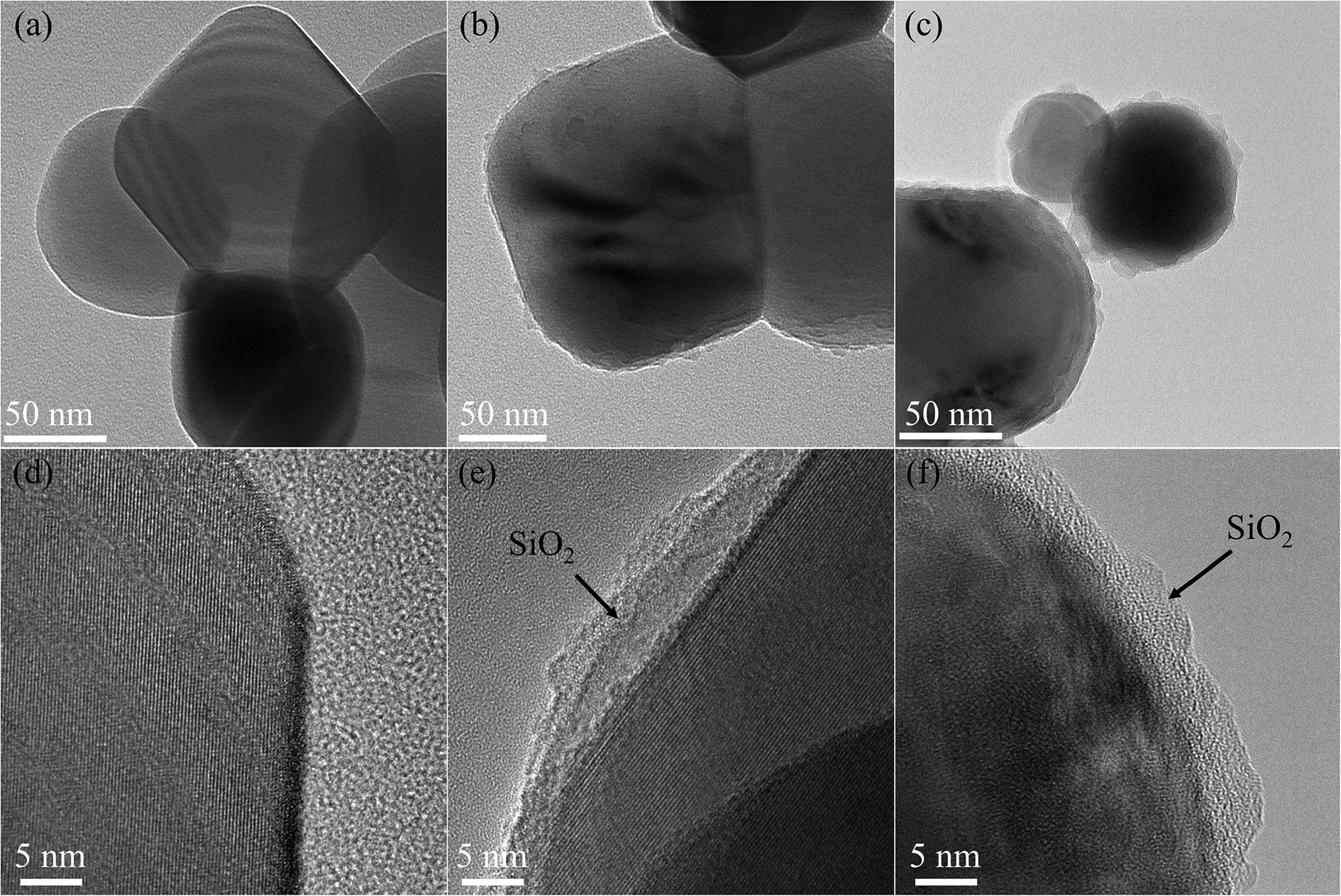
Fig.2. HRTEM images of:(a) uncoated TiO2,(b) TiO2/SiO2-P and(c) TiO2/SiO2-W particles and morphology of coating layer at the edge of(d)uncoated TiO2, (e)TiO2/SiO2-P and (f) TiO2/SiO2-W particles.
3.2.Composition of coating layer
Fig.3 is the FTIR spectra of the uncoated TiO2, TiO2/SiO2-P and TiO2/SiO2-W particles.There is a broad peak centered at around 3400 cm-1for all samples, which is attributed to the stretching vibrational absorption of the O-H at the TiO2particle surface.The peak at 1625 cm-1is the bending vibration of physically adsorbed H2O [34].The strong absorption peak between 450-700 cm-1is the characteristic peak for the bending vibration of Ti-O-Ti bond of TiO2particles [35].In the spectrum of both TiO2/SiO2-P and TiO2/SiO2-W, two more absorption peaks at 1000-1250 cm-1appear, which are the characteristic peaks of SiO2[36,37].And the absorption band of Ti-O-Si asymmetric stretching(around 950 cm-1) was also observed in the coated TiO2samples,confirming the formation of Ti-O-Si bonds during the P-CVD and wet chemical deposition process [38,39].
The resulting XRD patterns are depicted in Fig.4.The XRD pattern of uncoated TiO2used in this work showed the typical diffraction peaks at the positions of 25.3°,37.8°,48.0°,53.9°,55.1°,etc.All diffraction peaks of uncoated TiO2conform to the standard spectrum of anatase TiO2(JCPDS no: 84-1285) [40].No characteristic diffraction peak for crystalline SiO2is observed in the XRD patterns of both TiO2/SiO2-P and TiO2/SiO2-W particles, indicating that the deposited SiO2layers are amorphous[41],consistent with the conclusion obtained from the HRTEM analysis.

Fig.4. XRD patterns of the uncoated and SiO2-coated TiO2 particles.
The surface composition analysis of TiO2and TiO2/SiO2particles were carried out by XPS.Fig.5(a)shows that the O 1 s spectrum of uncoated TiO2consists of three peaks with binding energies (BEs)of 529.6, 530.3 and 531.1 eV,corresponding to the O2-of TiO2lattices, Ti-OH groups and adsorbed H2O, respectively [10].In the O 1 s spectrum of TiO2/SiO2-P, the peaks centering at 530.0 and 531.3 eV are assigned to the lattice O2-of TiO2and SiO2[42],respectively,while the peak at 532.7 eV is attributed to the surface hydroxyl groups (-OH) and adsorbed H2O.A blue-shift to higher binding energy is observed in Ti-O bond of TiO2/SiO2samples comparing with that of uncoated TiO2, because the amorphous SiO2layer makes the TiO2particles present a higher photon resistance,which also indicates that the SiO2film is anchored onto the TiO2according to Ti-O-Si bond [30,37].
Ti 2p spectra of naked and coated TiO2particles are shown in Fig.5(b).Ti 2p spectra of TiO2can be fitted with two peaks at 464.4 and 458.7 eV, which are attributed to Ti4+2p1/2 and Ti4+2p3/2, respectively [43].In the Ti 2p spectrum of TiO2/SiO2-P, the binding energies of Ti4+2p1/2 and Ti4+2p3/2 are 464.6 and 464.9 eV.And the binding energies of TiO2/SiO2-W increases by 0.1 eV.Because of the greater electronegativity of Si, the electron density around Ti decreases while the binding energy increases.The increase of the BEs of Ti 2p further confirms that the amorphous SiO2layers are anchored to the TiO2surfaceviaTi-O-Si bond.In addition, the spectra in Fig.5(c) reveals the presence of Si 2p spectrum of coated SiO2, centered at 103.5 and 103.4 eV,which are ascribed to SiO2in TiO2/SiO2-P and TiO2/SiO2-W respectively [5,42].XPS analysis also reveals the elemental composition of the particle surface, as shown in Table 1.The atom content of Si on the surface of TiO2/SiO2-P and TiO2/SiO2-W are 9.74% and 10.89% respectively, while no Si atom is detected on the uncoated TiO2particles,as expected,further confirms the successful deposition of the chemically bonded SiO2film.

Table 1Surface elemental atom composition (%) of different samples determined by XPS analysis

Fig.3. FTIR spectra of the uncoated and SiO2-coated TiO2 particles.
3.3.Photoactivity suppression effect
Dye degradation test is widely used in the field of catalysis engineering and has been proved to be an appropriate method for the photoactivity evaluation[44].Extensive studies have adopted RhB[45], MO [46]and MB [47]molecules as probes to estimate the photocatalytic activity of photocatalysts, which were also applied in the present work.
Exposure time of TiO2particles in the precursors will directly affect the thickness and uniformity of the deposited film [20].In order to obtain an optimized reaction time of TiO2with the precursor of SiCl4, samples with different SiCl4reaction time were prepared, and the resulting photoactivity of different samples were compared, as shown in Fig.6.
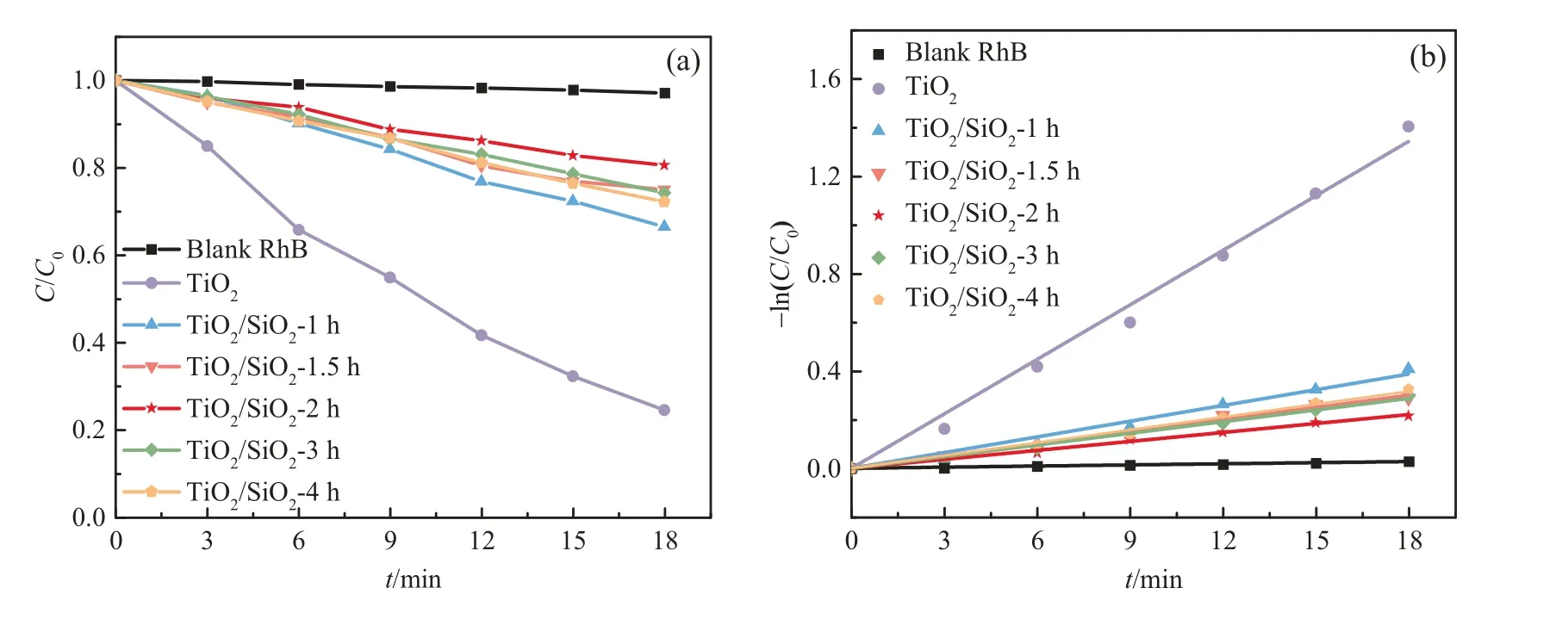
Fig.6. (a) Photocatalytic degradation of RhB with TiO2/SiO2 particles prepared under different SiCl4 reaction time and (b) corresponding kinetic plots.

Fig.5. XPS spectra of (a) O 1s, (b) Ti 2p and (c) Si 2p for TiO2, TiO2/SiO2-P and TiO2/SiO2-W particles.
It can be seen that the RhB suspension without TiO2particles degrades very slowly under their radiation of UV light, while uncoated anatase TiO2makes the RhB rapidly degrade because of its high photocatalytic activity.Comparing to that,the decomposition rate of RhB at the presence of SiO2-coated TiO2significantly decreases.According to the data analysis,the dye degradation rate can be estimated by the pseudo-first-order kinetic as follow [45]:

whereC0is the concentration of dyes when the equilibrium between the adsorption and desorption of the dyes with TiO2particles has reached,Cis the concentration of the dyes at timet,andkis the reaction rate constant.
Thekvalues for the photodegradation process with different TiO2particles are shown in Table 2, the TiO2/SiO2-2 h sample presents the lowestkvalue, indicating that theTiO2/SiO2-2 h sample suppress the photodegradation most effectively,therefore an optimized exposure time of the TiO2in the SiCl4of 2 h is determined for the coating process.Initially the suppression effect of the coated particles increases as the reaction time of TiO2with SiCl4increases,because a higher percentage of particles or larger surface area of the particles were coated.But when continue prolongingthe reaction time, more unreacted SiCl4could be deposited onto the particle surface, which then undergo homogeneous reaction with the second precursor of H2O to form granular SiO2, rather than heterogeneous reaction to form the chemically bonded SiO2.The granular SiO2could make the deposited film porous and less uniform, leading to a decreased photo-suppressive ability.

Table 2Apparent first-order rate constants (k) for the degradation of RhB using TiO2/SiO2 particles prepared with different SiCl4 reaction time
In order to compare the photoactivity suppression effect of the coated TiO2particles on different dyes, the decomposition experiments were also conducted with MO and MB, and the results are shown in Figs.7 and 8 respectively, where the apparent firstorder rate constantskfor the degradation of MO and MB are also presented.Apparently, comparing with the uncoated TiO2particles,the SiO2-coated particles can significantly slow down the photodegradation rates of all three kinds of dyes.
In order to compare the photoactivity suppression effect of the particles coated by P-CVD and the traditional wet chemical deposition method, TiO2particles coated by wet chemical deposition were also prepared,and the degradation results of RhB with different TiO2particles are depicted in Fig.9.A lowerkvalue of TiO2/SiO2-P indicates that the SiO2film from P-CVD can better suppress the photoactivity.According to previous HRTEM analysis, the film deposited by P-CVD is thinner, but with better shielding effect,indicating that the film from P-CVD is more uniform and compact.
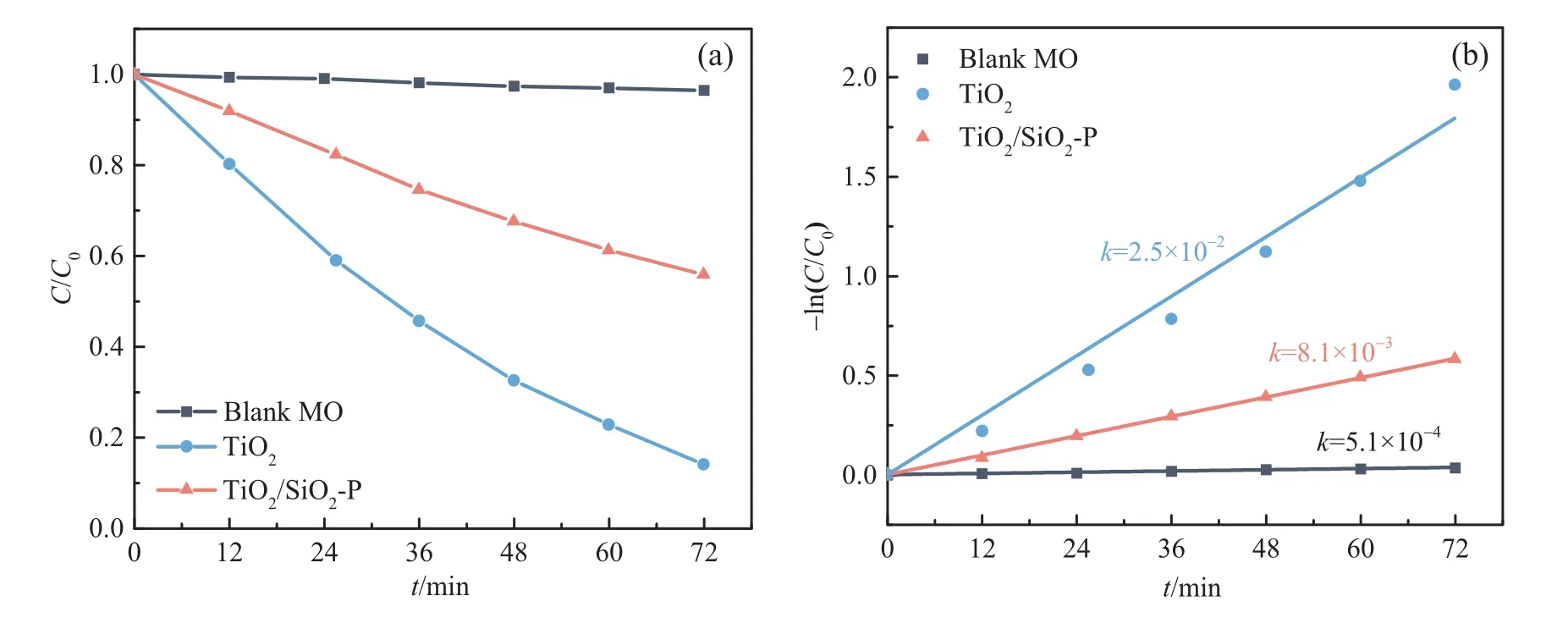
Fig.7. (a) Photocatalytic degradation of MO by uncoated TiO2 and TiO2/SiO2 and (b) corresponding kinetic plots.TiO2/SiO2-P in the figure is the sample TiO2/SiO2-2 h.
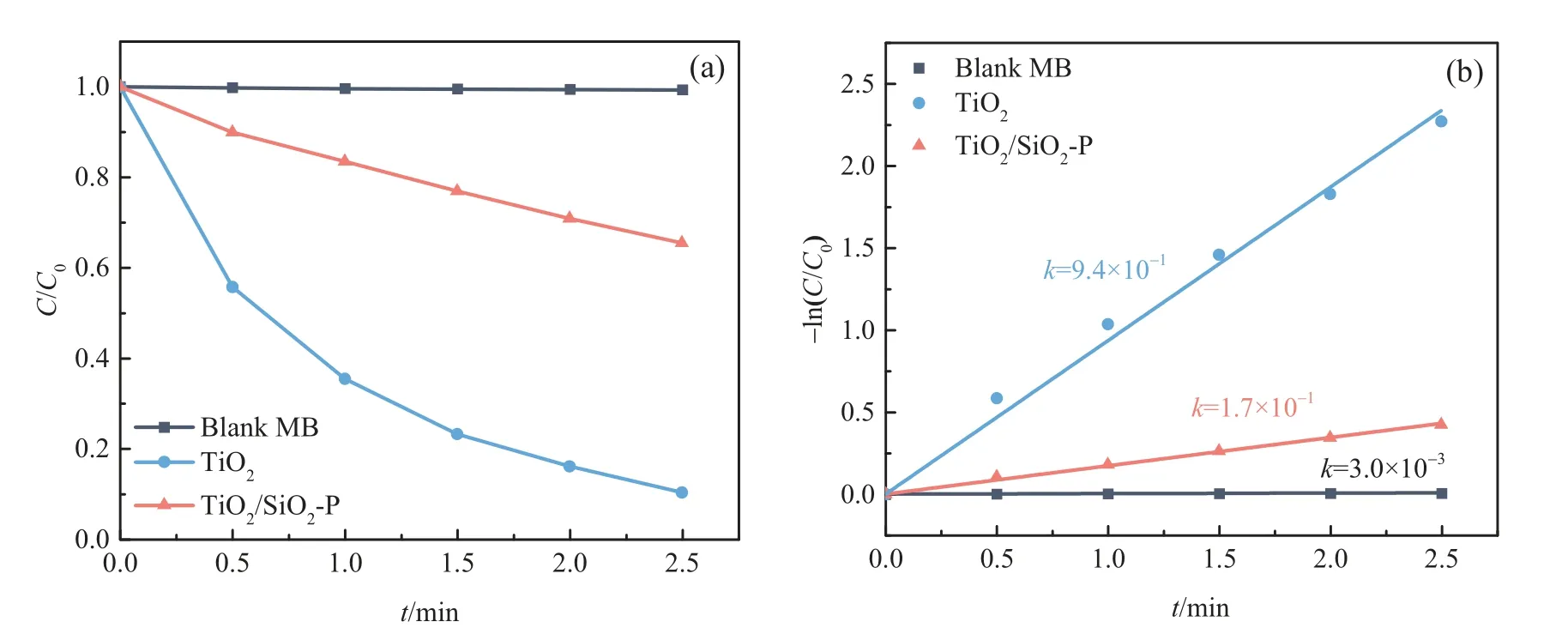
Fig.8. (a) Photocatalytic degradation of MB by uncoated TiO2 and TiO2/SiO2 and (b) corresponding kinetic plots.TiO2/SiO2-P in the figure is the sample TiO2/SiO2-2 h.
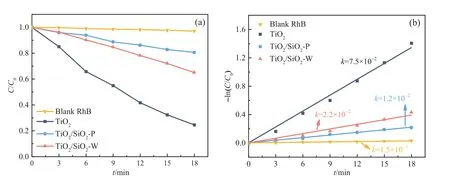
Fig.9. (a)Photocatalytic degradation of RhB by TiO2,TiO2/SiO2-P and TiO2/SiO2-W particles and(b)corresponding kinetic plots.TiO2/SiO2-P in the figure is the sample TiO2/SiO2-2 h.
Reproducibility is also an important feature for a production process.In order to examine the reproducibility of the quality of the P-CVD produced TiO2particles, five batches of SiO2-coated TiO2particles with a SiCl4reaction time of 2 h were prepared,(denoted as TiO2/SiO2-P-1,TiO2/SiO2-P-2,TiO2/SiO2-P-3,TiO2/SiO2-P-4 and TiO2/SiO2-P-5).From each batch of TiO2, three samples were randomly taken for the RhB degradation experiment.As shown in Fig.10(a), TiO2/SiO2-P presents a considerably lowerkvalue((1.4±0.26)×10-2)comparing with that of the uncoated TiO2particles ((7.8 ± 0.17) × 10-2).The obtained apparent first-order rate constants for the five batches of TiO2/SiO2-P are shown in Fig.10(b), apparently five batches of samples exhibit very similar photocatalytic activity, indicating that outstanding reproducibility and product stability can be obtained using rotary reactor for P-CVD production of SiO2-coated TiO2particles.
3.4.Pigmentary properties
3.4.1.Weatherability
Excellent pigmentary performance of TiO2is a prerequisite for the practical applications.Inert films with sufficient thickness are necessary to suppress the photocatalytic activity of TiO2,nevertheless, the films may affect the pigmentary properties of TiO2particles if the films are too thick.However, few studies have investigated the direct influence of the deposited films on the pigmentary properties of TiO2, such as weatherability, dispersibility,whiteness,etc.[6].
Weatherability is one of the most important application indicators, directly related to the downstream products [48].Normally the weatherability evaluation requires a long time to simulate the natural weather condition.Generally, it takes at least 1 year according to the outdoor exposure methodology [49], even the accelerated weathering test still requires about 1 month or more[49,50].
As already mentioned, the weatherability of the TiO2particles could be characterized by the amount of dissolved TiO2in the sulfuric acid,since the TiO2is soluble and SiO2is insoluble in the sulfuric acid.The most significant advantage of the weatherability estimation according to acid solubility measurement is that the test can be completed within 1 h, largely shortening the required time for the weatherability characterization.The acid solubility comparison of different TiO2particles was conducted and the result is presented in Fig.11.For the uncoated TiO2particles, the acid solubility reaches to 95%, meaning that most of the TiO2particles are dissolved.For the five batches of TiO2/SiO2-P particles,the acid solubility significantly decreases, which are 56%, 60%,57%, 58%and 58%,respectively.Compared with the products from wet chemical deposition, whose acid solubility also decreases, but less severely(89%),P-CVD coated TiO2particles present better acid resistance,indicating that the SiO2film obtained by P-CVD is more uniform and denser.
3.4.2.Dispersibility
The dispersibility of different samples were characterized by the zeta potential measurement,and the variation of zeta potential with respect to pH for the uncoated and coated TiO2particles are presented in Fig.12.When the surface of a TiO2particle is covered by SiO2, the particle tends to present similar electrokinetic behavior as pure SiO2[37].The isoelectric point of SiO2is around pH = 1.8-2.7 [39,51].The isoelectric point of the TiO2particles turns from pH = 3.2 to a lower value of 1.8 after the coating process, further confirming the surface modification caused by the SiO2layer [39].
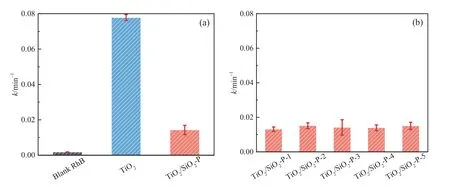
Fig.10. Apparent first-order rate constants(k)for the degradation of RhB with(a)uncoated TiO2 and TiO2/SiO2-P,(b)five batches of TiO2/SiO2-P obtained under the repeated P-CVD conditions.
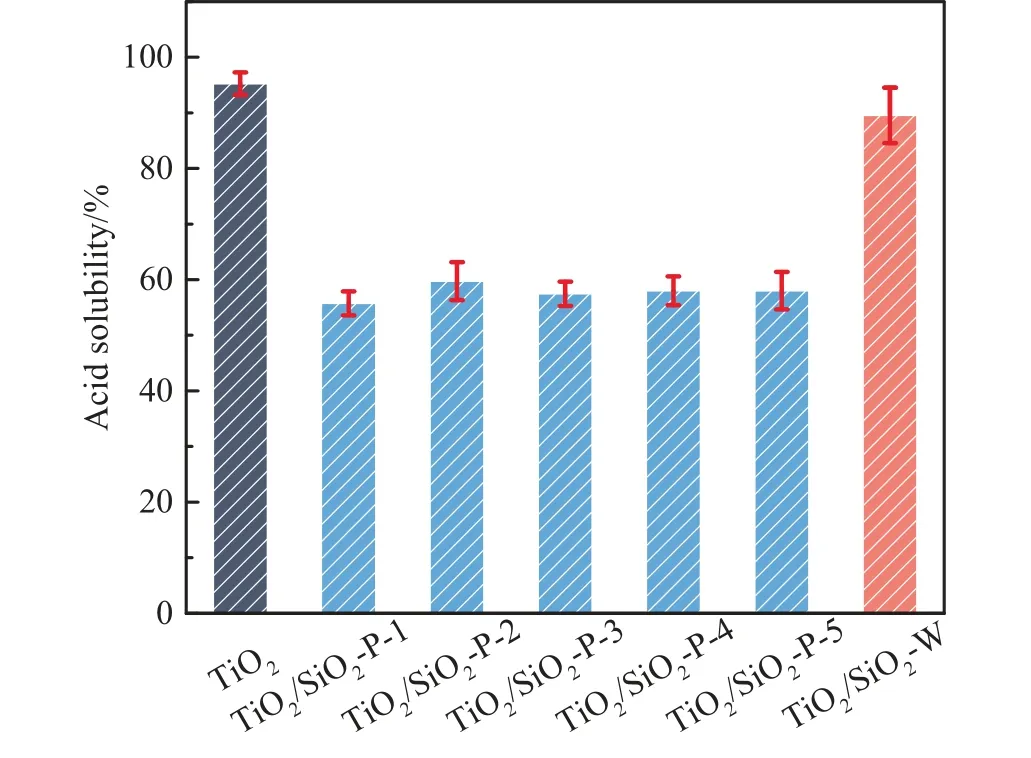
Fig.11. Acid solubility of the uncoated TiO2,TiO2/SiO2-P and TiO2/SiO2-W particles.Error bars: standard deviation (n = 7).
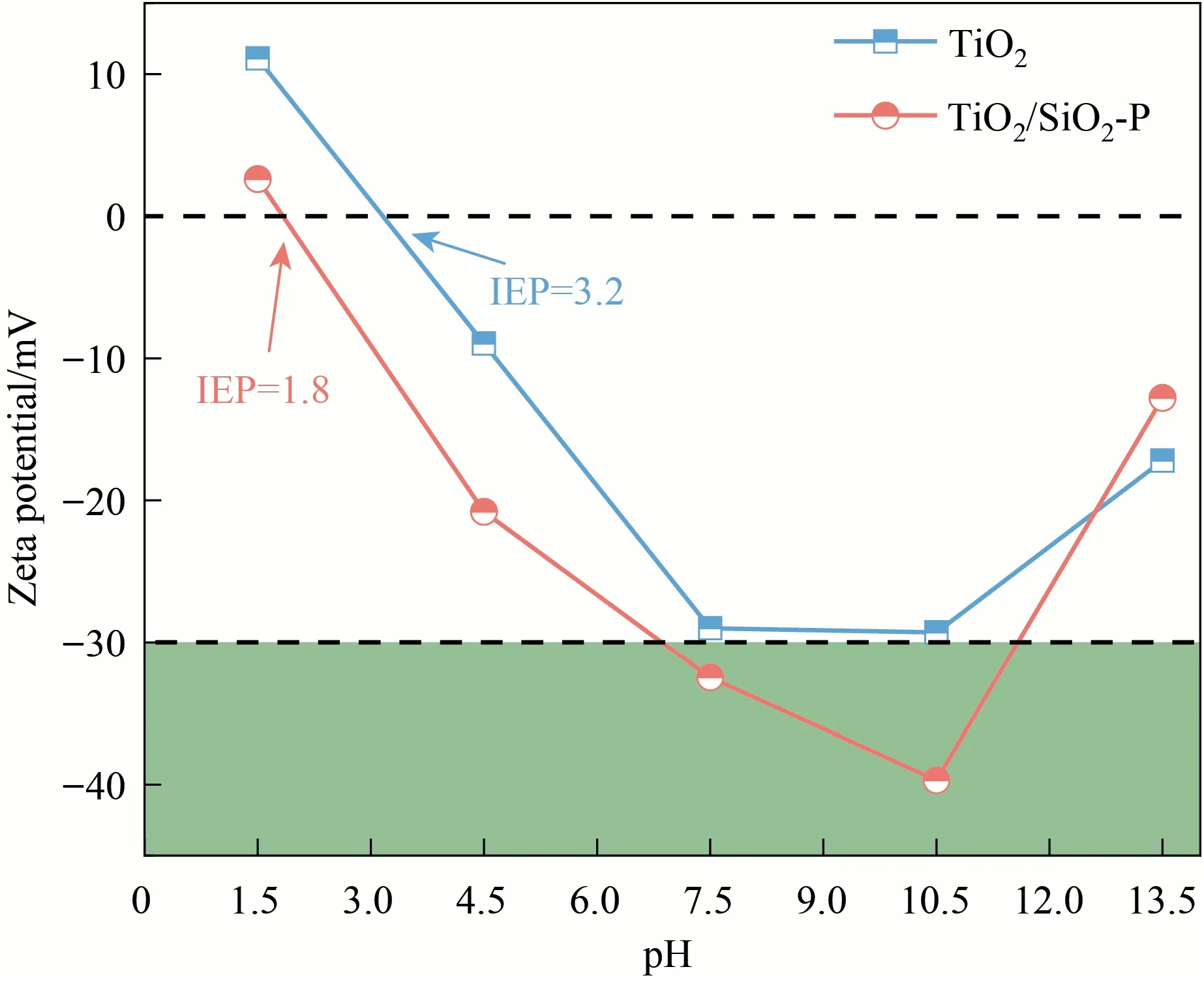
Fig.12. Variation of zeta potential value as a function of pH for uncoated and SiO2-coated TiO2 particles.
The zeta potential value of the particles at a specific pH can be directly applied to estimate the dispersion stability of a system.It is generally acknowledged that when the absolute value of the zeta potential is greater than 30 mV, the particles can be steadily dispersed in the medium, otherwise the high surface energy of the particles will easily lead to the agglomeration or flocculation [52].
It can be also seen from Fig.12 that,the absolute zeta potential value of the uncoated TiO2particle is lower than 30 mV in the wide pH range of 1.5-13.5,i.e.the uncoated TiO2particles will not steadily exist under such pH condition.However, the SiO2-coated TiO2particles from P-CVD present a promising potential of steady dispersion in the pH range of 6.9-11.6.
3.4.3.Whiteness
As the whitest material,whiteness is a critical parameter for the commercial value of the TiO2products[53].Fig.13 are the blue-ray whiteness measurement results for the uncoated TiO2,TiO2/SiO2-P and TiO2/SiO2-W, which are (98.2 ± 0.1)%, (97.3 ± 0.1)% and (97.2± 0.1)% respectively.The deposition of SiO2film will slightly reduce the whiteness of TiO2,but the products still maintain sufficiently high whiteness for application.
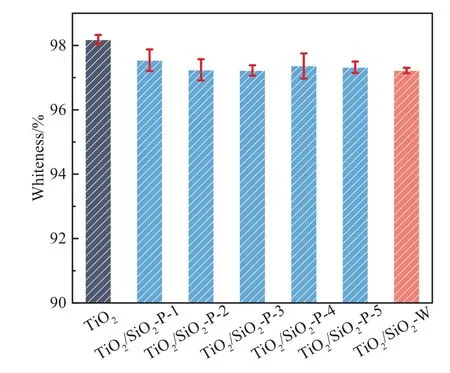
Fig.13. Whiteness of the uncoated TiO2, TiO2/SiO2-P and TiO2/SiO2-W particles.Error bars: standard deviation (n = 5).
4.Conclusions
In order to examine the applicability of rotary reactor on the scale-up production of SiO2-coated TiO2viaP-CVD at room temperature, and also examine the performance of the obtained TiO2products,a custom-designed rotary reactor and the corresponding coating process were developed in the present work.The obtained products from P-CVD,together with the uncoated particles and the TiO2particles coated by wet chemical deposition were characterized with various measures for comparison.The results of HRTEM and XRD has confirmed the successful deposition of an amorphous SiO2layer with a thickness of(3.7±0.7)nm onto the TiO2particles.The analysis of FTIR and XPS evidenced that the SiO2layers are anchored at the TiO2surfaceviaTi-O-Si bond.According to the photodegradation experiments of different organic dyes and the corresponding kinetic data analysis, the SiO2films can effectively suppress the photoactivity of TiO2particles, and the products present outstanding reproducibility according to multiple times of repeated tests.On the pigmentary properties, the acid solubility of the TiO2/SiO2-P samples decreased from 95% for the uncoated TiO2particles to an average value of 58%,which is also lower than the acid solubility of the TiO2/SiO2-W samples,indicating an obviously enhanced weatherability of the P-CVD coated particles.The zeta potential tests show that the TiO2/SiO2-P particles can be steadily dispersed in a pH range of 6.9-11.6.After the coating process,the whiteness of the TiO2particles has slightly dropped from (98.2 ± 0.1)% to (97.3 ± 0.1)% for the TiO2/SiO2-P particles and to (97.2 ± 0.1)% for the TiO2/SiO2-W particles, but still maintained sufficiently high whiteness for application.In summary, the SiO2-coated TiO2particles produced by P-CVD within the rotary reactor present satisfying pigmentary characteristics, and the customdesigned reactor has shown promising potential for the enlargement of the TiO2coating production.
Declaration of Competing Interest
The authors declare that they have no known competing financial interests or personal relationships that could have appeared to influence the work reported in this paper.
Acknowledgements
This work was supported by the National Key Research and Development Program of China(2018YFB0605700),National Natural Science Foundation of China(21908150)and China Postdoctoral Science Foundation (2019M653404).
 Chinese Journal of Chemical Engineering2022年5期
Chinese Journal of Chemical Engineering2022年5期
- Chinese Journal of Chemical Engineering的其它文章
- Notes for Contributors
- Solubility determination and thermodynamic modeling of bis-2-hydroxyethyl terephthalate (BHET) in different solvents
- Insights into the cross-amyloid aggregation of Aβ40 and its N-terminal truncated peptide Aβ11-40 affected by epigallocatechin gallate
- Numerical study on hydrodynamic characteristics of spherical bubble contaminated by surfactants under higher Reynolds numbers
- Spray-drying assisted layer-structured H2TiO3 ion sieve synthesis and lithium adsorption performance
- Innovative hydrophobic/hydrophilic perfluoropolyether (PFPE)/polyvinylidene fluoride (PVDF) composite membrane for vacuum membrane distillation
